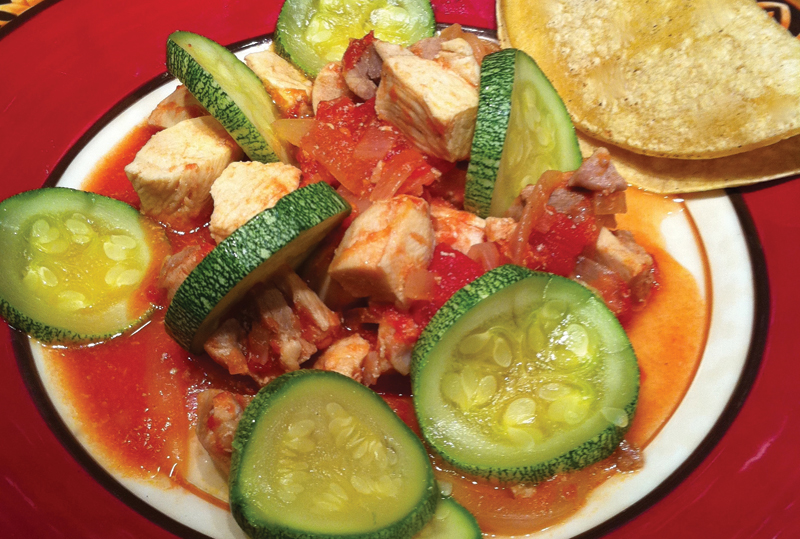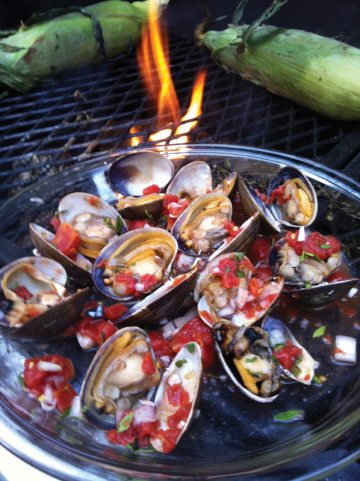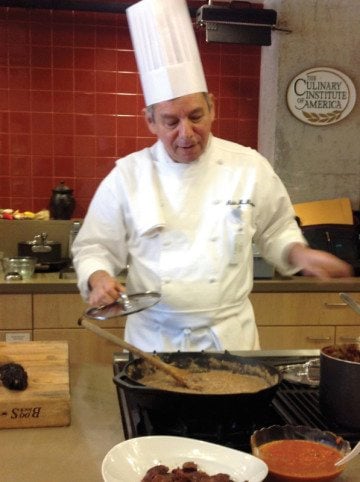
Adán Medrano Rediscovers Texas’ First Food in Truly Texas Mexican
A version of this story ran in the May 2014 issue.
The crowd that gathered in Mi Tierra’s El Mariachi Bar in San Antonio last November to hear Adán Medrano read from his soon-to-be-published cookbook, Truly Texas Mexican, wasn’t sure what to expect. César Martinez, at any rate, didn’t know what to expect. Martinez, a leading Chicano artist, knew that most of the people in the audience were artists, writers and academics, the great majority of them Latino. But why were they gathering for a cookbook launch?
Martinez knew Medrano as a filmmaker back in the mid-’70s, when Medrano started the Chicano Film Festival in San Antonio. “But I didn’t know he did food,” Martinez said in a recent interview, still sounding bemused almost six months later.
Medrano must have sensed the audience’s curiosity; he says he felt apprehensive that night. “These people were the fighters of the Chicano movement,” he said recently. “They don’t suffer fools gladly.”

How can a cookbook author be worried about appearing foolish? Isn’t it just a matter of whether the recipes taste good, and if the dishes photograph well?
Not in this case. Truly Texas Mexican is at least as much manifesto as recipe collection. In fact the recipes are part of the manifesto. And what is Medrano proclaiming? Nothing less than that he, his family, the audience, the entire Tejano/Chicano population of Texas and the Southwest, are a deeply rooted people, despite prevailing opinions to the contrary in both Mexico and the U.S. That they are the direct, if mixed, descendants of the 300 or so distinct peoples that populated pre-Hispanic Texas. The peoples who accompanied Cabeza de Vaca on his epic 16th-century walkabout. The peoples who lived on this land for thousands of years, and who traded and communicated with the indigenous peoples of Mesoamerica via the same routes de Vaca followed on his trek from Galveston to Mexico City.
That native Texas population numbered as many as a million Tonkawas, Mescal, Cauya, Pacuache, Yorica, and hundreds of other tribes, most with their own language or dialect. Disease, war and oppression reduced that population by some 90 percent by 1900. That remnant melted—or in this case, bled—into the Mexican population, learning to call themselves Tejano, Latino, Mexican-American or Mexican.
The audience at Mi Tierra wouldn’t have gathered that November night just to hear this sad and ancient history retold. But Medrano was presenting information that felt very much like news. He was there to declare that the culture of his audience’s indigenous ancestors had lived on, hidden in plain view, in the food that Medrano and his listeners had grown up on. Food that was once called “Mexican,” but that, like the people themselves, had been caught in a trap of nomenclature and identity, swept away in the Anglo tide. In the popular imagination, if not in fact, their food had morphed into Tex-Mex. But it wasn’t Tex-Mex at all.
Wearing a white chef’s jacket and standing behind a podium, Medrano read from his first chapter. Unlike Tex-Mex, which was invented by Anglos in the early 20th century, “Our food is authentically indigenous” to Texas, Medrano said. It is “very different from Tex-Mex. It is Texas Mexican.” The crowd was silent as Medrano explained that theirs is a cuisine with hundreds, even thousands of years of tradition. “Our dishes get their character from the culinary techniques developed over centuries in earth ovens, open fires, tree-bark bowls, granite mortars, griddles and shell-lined steaming ovens.”
You’ll notice the lack of a hyphen, likewise the lack of abbreviations, in the phrase “Texas Mexican,” which Medrano coined in recent years after he started to think more deeply about the food he grew up on, the enchiladas, frijoles, tamales and dozens if not hundreds of other dishes his mother cooked in their West Side San Antonio home. These foods often have the same name as their Tex-Mex counterparts, but Medrano insists they’re quite different. He tells the audience about the meat his father roasted in the barbacoa pit in their backyard, and how the technique dates back to indigenous ancestors.
His father dug his barbacoa pit decades ago, Medrano said, and “Four thousand years ago, around Olmos Dam, Native Americans had earth ovens” that served the same roasting purpose.
Again and again during his talk, Medrano emphasized the deep-rootedness of the food that he and much of his audience grew up on, and, not coincidentally, the depths of their own roots in Texas.
Through all of the mostly violent transformations visited upon the indigenous peoples of Texas, Medrano said, “Food was the cultural activity that held us together. Cooking nurtured our remembering; through it we invented new identities rooted in that remembering. Preparing food was a day-by-day regeneration. … We may have been devastated, but we can still cook.”
Medrano’s claim that the Latinos of Texas and the Southwest are in large part descendants of indigenous peoples is not original, nor is it controversial among historians and anthropologists. But his insistence that their food is a direct, if modified, descendant of native cuisines is an “eye-opener,” said Dr. Ellen Clark, professor emeritus of bilingual-bicultural education at the University of Texas at San Antonio.
Six months later, looking back on Medrano’s reading, Clark, who is Latina, vividly remembers the audience’s response. “People were whispering to each other: ‘Did you hear that? That’s incredible.’ The reaction was one of astonishment and pride. It was like finding out that Mayans developed all these amazing concepts that are not taught in our science books.”
The moment Medrano finished his presentation, Clark blurted, “Did you think a cookbook could be political?” Diana Barrios Treviño, a San Antonio restaurateur, spoke up to announce that she was going to quit calling her food Tex-Mex. “It’s Texas Mexican food,” she said. A young man stood up and declared that he was going to start referring to himself as “Texas Mexican.”
Bravely, if perhaps unwisely, one of the few Anglos present suggested that, because the history Medrano recounts predates both Texas and Mexico, Tex-Mex is as accurate a phrase as Texas Mexican, so why change? A woman shouted in response, “Hey, girl! I’m happy with Texas Mexican,” to general applause and laughter.

The 65-year-old Medrano has worn numerous hats besides his toque. In addition to being an accomplished chef and food scholar, he is a filmmaker, a former seminarian, and a world-traveling consultant on charitable giving and media. Sitting in the kitchen of the comfortable Houston Museum District house he and his partner, Richard Jimenez (a former AIDS researcher for the Centers for Disease Control) built in the 1990s, Medrano tells the story of his life—though you get the feeling he’d rather be talking about food and culture.
He and eight siblings grew up on San Antonio’s West Side and spent their summers as migrant farm workers. “We’d leave school early, in May, pick cotton all summer, and go back late.” He remembers his mother’s “poor, beautiful meals,” but he also remembers the backbreaking work and harsh living conditions in the work camps. And he remembers the cucumbers.
“I was 7, 8 or 9, picking cucumbers. The dirt was muddy and I was dirty wet with raw fingers from the cucumber leaves. Two college boys came by to take a survey. I was angry that they were going to look at me from the outside and say, ‘Poor thing.’ I was dirty and wet, but I had a brain.”
Medrano joined St. Anthony Seminary during high school and for nine years, through his undergraduate years at Creighton University in Omaha, Nebraska, remained on the path to the Roman Catholic priesthood. “I loved everything about seminary,” he remembers. “The lifestyle, prayer, community. But I didn’t think it was very nice to be obedient.” His bachelor’s degree was in film and journalism, and after leaving St. Anthony just shy of taking his vows, he continued to do audio-visual work for the seminary.
He went on to publish Catholic periodicals and produce a Spanish-language Catholic television series. In 1982 he moved to New York to become a part-time producer at CBS News. Next he took on the job that would occupy 23 years of his life and take him around the world: A consortium of religious and educational nonprofits hired him to oversee grant distributions to foreign institutions, and to advise those institutions on improving their media communications.
Among many other stops, the work led him to Rome, where he consulted with the Vatican and was invited to participate in the writing of one of John Paul II’s apostolic letters. Medrano met with the pope on several occasions and remembers him as a “very warm” man, though Medrano laments the missed opportunities of his papacy. “The bishops he named, and the intellectual discourse of the church, were not in tune with the times,” Medrano says.
In one of Medrano’s most surprising anecdotes, he remembers being invited to a party in the Sistine Chapel. As the party continued into the wee hours, he was given the key to the chapel and told to lock up when he left.
Jimenez also was traveling constantly for his work with the CDC, and the two saw each other infrequently. “We’d have to meet for lunch in the Atlanta airport,” Medrano recalls. Eventually they decided to quit the most travel-intensive parts of their careers and return to Texas. They built their home in Houston and Medrano continued consulting on media at his firm, JM Communications.
His travels had only deepened his interest in food. “I can look back at my mother’s kitchen with more understanding,” he says now. “I learned more about the link between food and culture.” He wrote about the two subjects on his blog, Adansblog.com. He also began to think about the way his culture’s cooking had been marginalized in favor of Tex-Mex.
About five years ago, he began to cook with more focus. Jimenez encouraged him to try culinary school. “You’ll be enriched, no matter what you do with it,” Medrano remembers him saying. He had begun the process of applying to the prestigious Culinary Institute of America in Hyde Park, New York, but when he saw that the institute had opened a school in San Antonio, in large part to study and promote the cuisines of the Americas, he and Jimenez took an apartment there, and he began his studies.
Medrano says he and other students soon noticed that the classes on Latin American foods included sections on Peru, Argentina and Mexico, “but we wondered why they didn’t deal with our Texas Mexican cuisine—though we weren’t calling it that.” Medrano and his fellows decided it was because “overly commercialized” Tex-Mex had virtually obliterated all awareness of native Texas cuisine outside of the community that still cooks it. He also saw that Mexican cooking was presented in terms of regions: Oaxaca Mexican, Puebla Mexican, Veracruz Mexican, Jalisco Mexican. That’s when he began thinking about his native food as its own regional Mexican cuisine: Texas Mexican.
Taking his cues from anthropologists and historians, Medrano began working on Truly Texas Mexican. (It’s his second book; his first, Belief in Media, was a study on the relationship between media and religion.) Two years of research led to a year of writing—on spec. Though he didn’t have a publisher, for four months he spent 10 hours a day in his home kitchen, testing recipes. Some he remembered from his mother’s kitchen, some he found in old cookbooks, some he got from his siblings. In all he composed 100 recipes.
So, how does Texas Mexican differ from Tex-Mex? For starters, it’s a more complete cuisine, with hundreds of dishes instead of Tex-Mex’s 20 or so. And the dishes themselves are generally lighter and healthier, and feature more carefully wrought flavors. Enchiladas are a good example. In the Tex-Mex enchilada, Medrano says, “the tortilla is just a wrap” to hold the ingredients together. But in the Texas Mexican enchilada, he says, “The tortilla is the enjoyment. It’s not a wrap, it’s the thing itself.” The word “enchilada” means “chile-ed,” so the tortilla is coated with chile ancho and guajillo. The cheese will be a light, crumbly queso fresco, which, unlike the melted cheese in the Tex-Mex version, is not the focal point of the dish. The resulting enchilada is lighter in both texture and flavor, especially if, like Medrano, you devein the guajillo and are left with all of its flavor but little of its heat.
His recipe is specifically Texas Mexican because the chile sauce is thickened with flour, which distinguishes it from other regional Mexican cuisines.
A large part of the difference comes down to the attitudes and ambitions of the cook. The chefs at San Antonio’s Mixtli, which features modern versions of regional Mexican cuisines, plan to do a Texas Mexican menu to match their Oaxaca Mexican and Jalisco Mexican meals.
Such an idea would be absurd if applied to Tex-Mex. It’s hard to argue with critic Dave Hickey’s contention, proudly reproduced on the menu of Houston’s shrine to Tex-Mex, El Real, that “Rock and roll is like Tex-Mex. As it improves in quality, it ceases to be what it is.”
Some of the recipes in Truly Texas Mexican are accompanied by historical and anthropological mini- essays, the likes of which you won’t find in other cookbooks. The recipe for powdered shrimp cakes explains not only how to make them, but how they make Medrano think of the coast-dwelling, crab-eating Karankawas, who apparently succumbed to their Texan, Mexican and Comanche adversaries in the 1850s. (Medrano holds out hope that they weren’t completely obliterated, referring to a 2009 McAllen Monitor article about the death of a man who claimed to be half-Karankawa.) Medrano relates how the Karankawas saved Cabeza de Vaca and his companions after their shipwreck, then ends with a quote from the laureate of French food writing, Jean Anthelme Brillat-Savarin, on the subject of “the action of foods on man’s morale, on his imagination, his spirit, his judgment, his courage and perceptions.”
Texas Tech University Press published Truly Texas Mexican in late April as part of its Grover E. Murray Studies in the American Southwest series. Various academics have already touted the book’s importance. Jeffrey Pilcher, a noted historian of Mexico and Mexican food, wrote in an email that, “Within the last ten years, people have started recognizing the cuisine (Tex-Mex) as an original American regional food. While this has been a worthy change, people have not really traced the roots of the cuisine, particularly to the distinctive indigenous groups of the region, which is what Adán does.”
Mario Montaño, chair of the Department of Anthropology at Colorado College in Colorado Springs, emailed that Medrano is “making a scholarly contribution” to “documenting the lives of working class Mexicans of South Texas” by “going to the archaeological record and making the argument that those [native] people had [their own] way of cooking. What he’s doing is providing this history which has been neglected or suppressed.”
Medrano’s recipes are indeed “delicious intellectually,” as he claimed at Mi Tierra. But at the end of the day, a recipe has to taste good. Medrano recently returned to the Culinary Institute of America, not as a student but as a presenter of his Texas Mexican recipes. That audience consisted not of Chicanos attracted to the intellectual underpinnings of his talk, but of mostly young would-be chefs eager to sample the “flavor profile” of his dishes. Wearing his toque and chef’s jacket and working in the institute’s Demo Theater, he looked excited and happy, more in his element than he had been behind the podium at Mi Tierra.
The audience watched with rapt concentration as he demonstrated the making of carne con chili, well-fried (as opposed to Tex-Mex’s “refried”) beans and chile ancho adobo. Everything was delicious: light, expertly spiced and not overpoweringly hot. (Medrano cautioned the students, “If your vendor tries to sell you chiles based on how hot they are, find another vendor.”) The well-fried beans are a case study in how Texas Mexican cooking differs from Tex-Mex. Tex-Mex beans have been pureed to a “baby food texture,” Medrano says. Medrano stirred his beans for 30 minutes or so after crushing them, rather than pureeing them, so that the dish had a somewhat flaky texture and included flecks of bean skin. Refried beans are also usually flavored with either bacon or lard, while Medrano’s beans include no added fats.
Medrano’s carne con chile is also very different from the usual chili con carne. “Tex-Mex ‘chili’ gets billed as ‘3-Alarm,’ to emphasize the heat,” Medrano says. “But we take the seeds out of the guajillo so we just get the flavor.” (If you like your chile con carne picante, he suggests adding chopped jalapeno before serving.)
After everyone had enjoyed a few bites, Medrano asked for questions. There was only one. “Where can you find this kind of cooking?” a young woman asked. “Can you recommend any restaurants?”
The fact that it’s hard for him to do so shows how thoroughly Tex-Mex has come to dominate the Mexican food scene. Texas Mexican food is mostly made at home. Medrano named a humble-sounding West Side San Antonio place, El Puesto No. 2. In Houston he recommends the somewhat upscale Sylvia’s Enchilada Kitchen, which bills itself as offering “a taste of the Rio Grande Valley,” and the more modest Doña Chela, near Hobby Airport.
The next day Medrano went to El Puesto No. 2 for breakfast. The items on the breakfast menu don’t look particularly exotic for this part of the world: chilaquiles, machacado con huevo, huevos rancheros. It’s food you’ll find on both sides of the Rio Grande. So what makes El Puesto No. 2 different from, say, El Rancho, or Chuy’s, or Spanish Village? Mainly it’s the lightness and freshness of the food, which is made without added animal fat, and the subtle flavor of the salsa. In particular, it’s the freshness and texture of the corn and flour tortillas. In Tex-Mex restaurants, Medrano often finds himself sending flour tortillas back for more comal time. “Look at these,” he’ll say, picking apart a tortilla. “They’re raw.”
One night when the state of a Chuy’s tortilla got him down, and he could hardly bring himself to taste his enchiladas, Medrano had to talk himself out of exasperation. “It’s crowded here, and the people are having a good time. They must be doing something right,” he said. Then he added, “I don’t want to attack the way anybody else eats. I had that done to me when I was a kid.”

